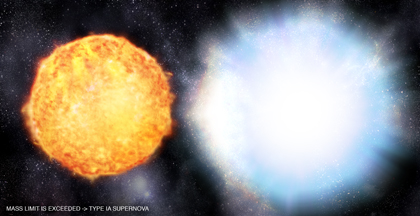What Triggers Cosmology's Most Important Explosions?
The work by Gilfanov and Bogdan described in the recent Chandra Press release represents a major advance in understanding the origin of Type Ia supernovas. Here, in Q & A format, we give some of the backstory of this important discovery.

Illustration: NASA/CXC/M.Weiss
What is a Type Ia supernova?
A Type Ia supernova is thought to occur when a dense stellar remnant called a white dwarf somehow exceeds its weight limit and undergoes a thermonuclear explosion. Their peak brightness is generally greater than that of core-collapse supernovas, the class of supernova caused by the collapse of a young, massive star. Historical Type Ia supernovas such as Tycho's supernova were spectacular events, visible in the daytime by early astronomers.
http://chandra.harvard.edu/xray_sources/supernovas.html
What triggers these explosions?
The two main possibilities are the accretion scenario and the merger scenario, as explained in the press release. This work provides direct evidence against the accretion scenario in elliptical galaxies, implying that the merger scenario dominates in these galaxies. The accretion scenario is much more difficult to rule out in spiral galaxies because the presence of large amounts of cold gas and dust absorbs low energy X-rays expected from accreting white dwarfs and makes the interpretation of the data considerably more difficult.
Read the full article
-P. Edmonds, CXC
Please note this is a moderated blog. No pornography, spam, profanity or discriminatory remarks are allowed. No personal attacks are allowed. Users should stay on topic to keep it relevant for the readers.
Read the privacy statement
